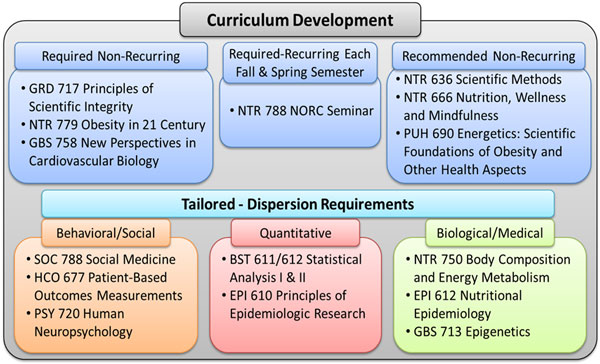The Research Experience
Trainees are expected to spend a minimum of 20 hours per week at UAB engaging in their work. Their obligations for classroom activities, journal clubs, meetings, and workshops must first be met. Their remaining work time is expected to be spent working on their research projects. After the first year in the program, trainees are expected to exceed 20 hours per week engaging in their work. Even in their first year, trainees should not spend much less than 20 hours per week engaging in their work.
Publications.
All trainees are required to have a first-authored publication by the end of their first year on the T32. The plan involves working with the mentor team within 30 days of the student’s T32 acceptance to identify existing data that can be used for analysis and manuscript development. Such data sets may include any of several longitudinal cohort studies that are based at UAB (or have a site at UAB) that involve cardiovascular disease, such as REGARDS (REasons for Geographic and Racial Differences in Stroke), CARDIA (Coronary Artery Risk Development in Young Adults), and RURAL (Risk Underlying Rural Areas Longitudinal, RURAL). Data from numerous smaller interventional, experimental, or observational studies conducted by NORC investigators are also available to students. The student will then work with his/her mentors to develop a 1-page summary of the rationale, specific aims, and hypotheses to be addressed. This outline will form the basis for a methodical exploration of the scientific method. The student will learn to conduct a literature review, conduct basic statistical analyses, report data in tabular and graphic formats, interpret the results, and write each section of the manuscript following accepted editorial guidelines for both basic grammar and syntax, and scientific writing (e.g., Strunk and White’s Elements of Style; Kamler & Thomson’s Helping Doctoral Students Write, 2nd edition). Progress will be tracked through regular meetings of the mentor team, and status reported to the program director. Trainees are expected to complete data analysis, preparation of tables and figures, and the results section at the first 6-month mentor team meeting. In addition, the trainee should submit the manuscript (or in final draft) at the first annual mentor team meeting.
Interdisciplinary Curriculum.
Trainees participating in the program are provided a baseline of knowledge pertinent to obesity and HLB disease. The educational training is based on three categories of courses: Required Non-Recurring, Required-Recurring, and Tailored-Dispersion Requirements (as shown in the Curriculum Development figure). Tailored Dispersion Requirements are flexible and other courses can be used instead of the ones proposed.
 A “Walking” Journal Club is required to participate in this program. The Journal Club is offered on the third Friday of each month (excluding Summer), in a breakfast setting that starts at 7:30 a.m. Dr. Fernández serves as the organizer of this journal club in which assigned mentors lead the discussion of a journal article of their choice, providing an opportunity to expose trainees to a diversity of topics that relate to HLB disease. Participation is required of all T32 students.
A “Walking” Journal Club is required to participate in this program. The Journal Club is offered on the third Friday of each month (excluding Summer), in a breakfast setting that starts at 7:30 a.m. Dr. Fernández serves as the organizer of this journal club in which assigned mentors lead the discussion of a journal article of their choice, providing an opportunity to expose trainees to a diversity of topics that relate to HLB disease. Participation is required of all T32 students.
Seminars.
All trainees are expected to attend the weekly NORC seminar series. This seminar series takes place from the beginning of September through the end of May in each academic year. In addition, there are special seminars throughout the year. A truly outstanding cast of internal (UAB) and external nationally and internationally recognized speakers provides state-of-the-art lectures on topics related to obesity and other aspects of nutrition from virtually every perspective. In addition, T32 students are required to participate in an organized lunch immediately following the seminar with the presenters. These lunches create opportunities for both an intimate interchange of scientific knowledge and ideas and networking. Our trainees also have the opportunity to attend dinners with seminar speakers on a rotating basis. The dinners are designed to expose trainees to the socialization process that underlies scientific relationships and collaborations. Many other seminars are given throughout the university on closely related topics such as hypertension, cardiovascular disease, epidemiology, and diabetes. Trainees may participate in these other seminars at their respective mentors’ discretion.
Training in Scientific Presentations.
All trainees are expected to make at least one presentation per year. In their first year of training, the presentation may be as informal as participating in a journal club presentation in collaboration with their mentors. Thereafter, they will be expected to make one formal presentation per year. UAB provides many formal presentation opportunities including the School of Public Health Research and Practice Day, the Comprehensive Center for Healthy Aging Annual Meeting, the Department of Medicine Research Trainee Symposium, the UAB Health Disparities Research Symposium, and the UAB Center for Exercise Medicine and the Comprehensive Cancer Center’s Annual Meeting. These presentation opportunities also provide venues for our trainees to receive awards. Additionally, our trainees are encouraged to present their research at other local universities including: at Boshell Diabetes Research Day at Auburn University and the Nutrition Symposium at Samford University. Finally, after their first year of training in the program, each trainee will be expected to make an annual presentation at a national scientific conference. Examples of conferences include, but are not limited to: the American Heart Association, The Obesity Society, Experimental Biology, and the Society for Clinical Research.